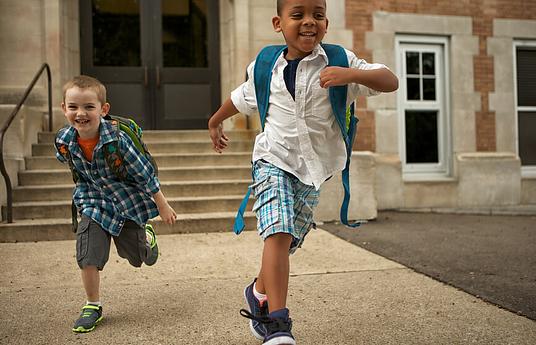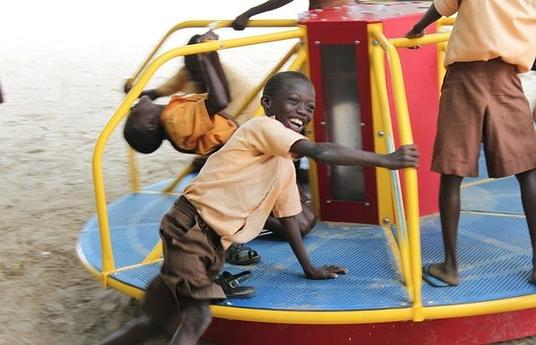Gym Class. For some of us, those words send us into a reverie, with glowing memories of being carried on teammates shoulders after a jaw dropping goal or smashing our personal best on the track. For others, the mere mention of team sports and fitness drills is nothing short of nightmarish. But, love it or loathe it, physical education is a vital part of any education.
Though a minimum of 60 minutes per day of moderate to vigorous activity is recommended (the more activity, the greater the health benefits), even a modest amount of physical activity can have health benefits in high-risk young people, such as those with obesity. Physical education plays a key role in keeping children fit, encouraging healthy habits that last a lifetime and building up other key skills too.
Sufficient childhood exercise can boost cognitive function in the short term and long term and protect against a number of diseases in adulthood. Moderate to vigorous physical activity is also linked to increased academic attainment as well as being a boon to mental health, increasing confidence and self esteem while zapping stress and anxiety.
With all of these benefits, you might expect every child to be hopping, skipping and jumping their way to better health, but this is sadly not the case. In many western countries, childhood is no longer a time of climbing trees, jumping rope or running free. Traditional pursuits have given way to technology based hobbies that involve kids spending inordinate amounts of time sitting indoors. Whatsmore, parents are increasingly worried about child safety and are reluctant to let them walk to school, while teachers are so pressed for time that the schedule is often rammed, leaving learners effectively glued to their seats. In the UK, children are the least fit they have ever been and experts say their sedentary lifestyles are to blame. Research suggests children should be engaged in moderate to vigorous activity for at least 60 minutes each day, but shockingly only half of UK children are meeting this minimum target.
Physical education class is one way that schools can help to tackle the issue of sedentary behaviour in childhood, but are we being too short sighted in restricting movement to this one lesson?
UK Active, a not-for-profit body focused on raising activity levels, have made a number of recommendations aimed at making activity the norm again for the UK’s children. These include; a national standardized measurement of fitness (currently schools have little knowledge of their students’ fitness levels), changing the focus from ‘sport’ to a more broad definition of ‘physical activity’ to increase awareness that there’s many fun ways to get active, and taking a whole day approach to activity (including the journey to school, recess and after school activities).
"There are so many opportunities to incorporate movement into the school day but they too often go missed, partly because of the belief that gym class and recess has the movement quota covered"
It seems like a whole day approach is exactly what’s needed. In the UK it’s up to schools to decide how much curriculum they yield to physical education, with the government suggesting a minimum of 2 hours per week. But if we break that down and take into account time spent changing into kit, putting out equipment and receiving instruction, kids spend little time engaged in vigorous activity even in a lesson that centres around this. Taking a whole day view of activity, not allocating it purely to gym class, could help every child smash the 60 minute daily target. Encouraging walking or cycling to school, either with a ‘walking bus’, car free zones or a whole class reward system, gives kids a much needed burst of activity right from the word go and feeds their brain and body for the day ahead.
Physical activity benefits concentration and attention, so getting kids moving in class really is a no-brainer. Teachers can set kids up for success by starting the day off with movement and can use physical activity to re-energize learners during or between classes. Brain gym exercises are popular with many educators as a quick way for students to burn off excess energy, melt away any stress and reinvigorate their minds, ready to learn. There’s a whole range of ideas and resources out there, from simple seated stretches to brain boosting dance videos to online yoga videos designed for the classroom. The BBC even launched an initiative called ‘Super Movers’, which gives teachers simple solutions to help children learn while they move, using free curriculum aligned videos featuring celebrities and sports people, on topics ranging from decimals to punctuation marks.
Thinking outside the box can also help. Allowing for organic movement, as well as timetabled activity, all contributes towards more active kids. A flexible seating approach can encourage movement in the classroom, allowing kids to move around freely and use up excess energy, giving increased motivation and engagement as well as potentially improving core strength and overall posture.
It’s important that schools make the quest to increase movement as inclusive as possible. Every child can benefit from activity, but some will need more support to access it, for instance children with physical disabilities may need additional support and tailored activities and movement can be extremely beneficial for children with a range of additional needs. 5% of US children have been diagnosed with Attention Deficit Hyperactivity Disorder (ADHD), meaning that an average classroom is likely to have at least one child experiencing this condition, which is often accompanied with other conditions like anxiety, depression or emotional and behavioural disorder. Children will ADHD love to and need to move, but in the classroom they aren’t normally able to express this. In addition, research shows that girls are consistently less active than boys, with some suggesting that this is due to less social support to engage in physical activity and may perceive less enjoyment when taking part in physical education through lower participation in community sport.
"Physical activity benefits concentration and attention, so getting kids moving in class really is a no-brainer."
When children with additional barriers miss out on physical activity they miss out on all the benefits that come with it, something that could have far reaching consequences for their health, wellbeing and success, so it’s vital that schools come up with strategies to help them find ways of moving that suit them. Sensory circuits before class can be a great way for children to have their sensory and movement needs met, as well as incorporating brain boosting exercises for all learners throughout the school day.
It’s not just what happens in the classroom that counts; choice and variety is key here. Some children are sporty, whilst others aren’t, but that doesn’t mean they can’t be active. Any activity that gets kids moving, whether it’s playing, dancing or running around, should be encouraged. Schools should be able to provide equipment and facilities, such as inspiring playgrounds and engaging equipment. Outdoor learning gets kids out from behind a desk and into open spaces like forests, parks and playgrounds, where they are more likely to be active. Getting creative with the playground design, by using traditional and non-traditional equipment (like car tyres, wooden logs and recycled items) can also promote physical activity among children and young people by giving them more of a range of opportunity for movement - clambering, swinging, running and jumping.
But play equipment isn’t the only resource to get kids moving, staff can also be leveraged to facilitate active play. Through training and with support, staff can understand the importance of activity and know effective ways to encourage movement and play. Trained Play Leaders, whether lunchtime staff or students, can help encourage kids to take part in traditional playground games like hopscotch, jump rope and clapping games - increasing movement during recess and also encouraging inclusion for children who find it hard to make friends. Sports coaches and dance teachers can be brought in to facilitate structured activity and competitive sport, whether it’s before and after school or during lunch break, helping to cater to all tastes and get kids to try new sports or activities with their friends.
While learning to play hockey and skidding through mud in cross country running are important parts of growing up, we mustn’t trick ourselves into thinking physical education ends at gym class. There are so many opportunities to incorporate movement into the school day but they too often go missed, partly because of the belief that gym class and recess has the movement quota covered. Movement and physical activity can and should be encouraged before, during and after school as well as during each and every lesson to make sure active, healthy and engaged kids become the new normal.


